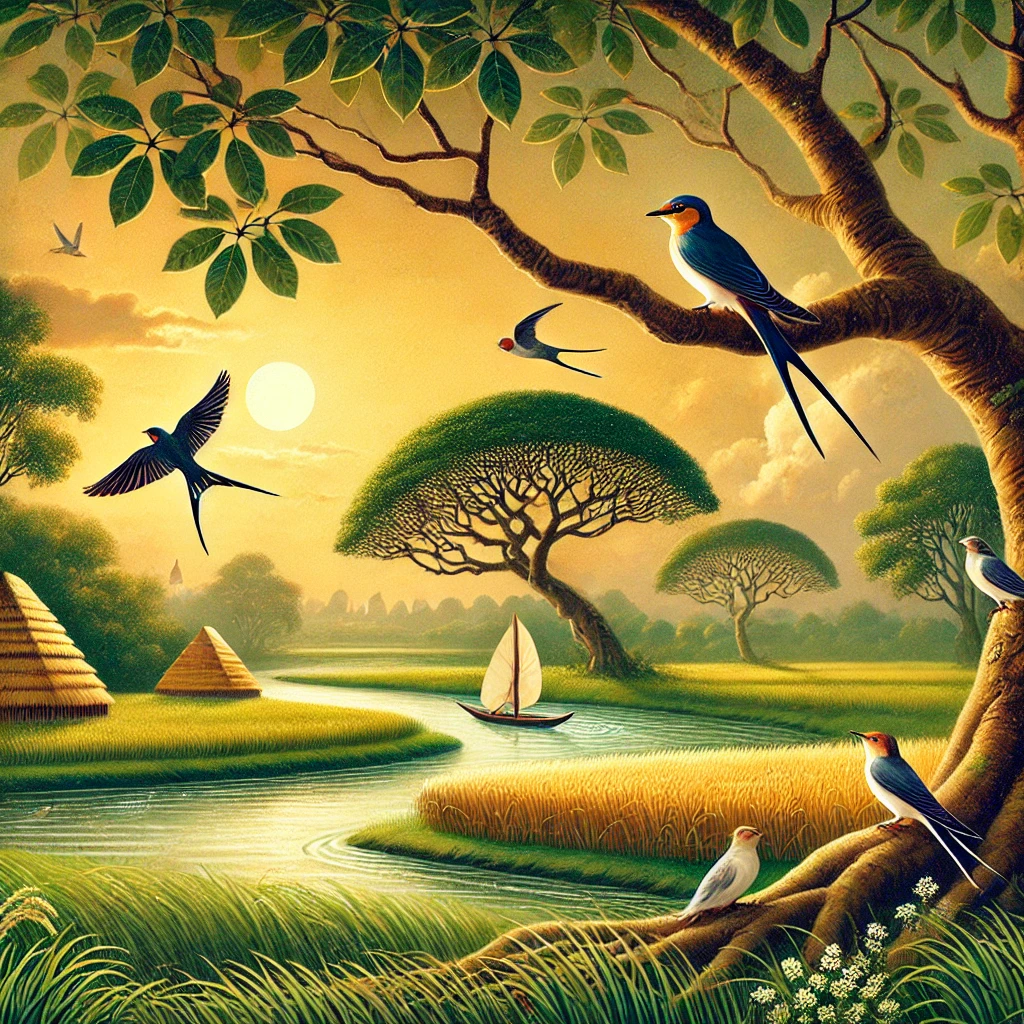HSC English 1st Paper 2024 | Unit Three: Myths and Literature

HSC Unit Three: Myths and Literature
Lesson 1
Myths of Bengal
A. Warm up activity
What is a myth? Look up the meaning of the word in a dictionary or on the Internet.
What kind of myths do you think we can find in our culture?
B. Now read the following poem by Jibanananda Das (1899-1954) in English translation and then answer the questions either by responding to your classroom teacher in English or by trying to write down answers in your notebook.
I Have Seen Bengal's Face¹
Because I have seen Bengal's face I will seek no more, The world has not anything more beautiful to show me. Waking up in darkness, gazing at the fig-tree, I behold Dawn's swallows roosting under huge umbrella-like leaves.
I look around me and discover a leafy dome, Jaam, Kanthal, Bat, Hijol and Aswatha trees all in a hush, Shadowing clumps of cactus and zedoary bushes.
When long, long ago, Chand came in his honeycombed boat To a blue Hijal, Bat Tamal shade near the Champa, he too sighted
Bengal's incomparable beauty. One day, alas, in the Ganguri, On a raft, as the waning moon sank on the river's sandbanks, Behula too saw countless aswaths bats besides golden ricefields And heard the thrush's soft song. One day, arriving in Amara, Where gods held court, when she danced like a desolate wagtail, Bengal's rivers, fields, flowers, wailed like strings of bells on her feet.
Translation of Jibanananda Das's "Banglar Mukh Ami" by Fakrul Alam
Answer to the question No- C
Here are the meanings of the words listed in Question C based on their usage:
- Gazing: Looking intently with focus or admiration.
- Roosting: Birds resting or settling to sleep, typically in a perch.
- Dome: A rounded structure or shape, often like the top of a building or natural canopy.
- Hush: Silence or stillness; a quiet environment.
- Honeycombed: Having a structure or pattern resembling a honeycomb, often with small spaces or holes.
- Waning: Becoming smaller, weaker, or less intense; often used for the moon's phases.
- Desolate: Empty, lonely, or abandoned; lacking life or activity.
- Wagtail: A small bird known for wagging its tail up and down.
- Wailed: Cried out loudly, often in grief or sorrow.
These meanings align with the context of Jibanananda Das's poem, where they describe the beauty and atmosphere of Bengal.
Answers to the questions in D:
-
Have you heard about Chand Saudagar and Behula before? If so, in what context? Where is Ganguri and Amara?
- Answer: Yes, Chand Saudagar and Behula are well-known characters from the Bengali medieval epic Manasamangal. Chand Saudagar is a merchant, and Behula is his devoted daughter-in-law. The story revolves around their struggles with the goddess Manasa. Ganguri is the river where Behula sails to heaven to bring her husband Lakhindar back to life. Amara is the heavenly abode where the gods reside.
-
Discuss with your classmates the medieval epic Manasamangal. Do you know of any modern Bangla versions of this epic?
- Answer: Manasamangal is one of the most famous medieval Bengali epics that narrates the worship of the snake goddess Manasa. It portrays themes of devotion, perseverance, and mythological battles. Modern Bangla versions of this epic include adaptations in folk dramas, songs, and even movies that bring the story to contemporary audiences.
-
Look up the story of Behula and Chand Saudagar from Wikipedia or Banglapedia. Make a summary in about 200–250 words.
- Answer: Chand Saudagar, a devout worshiper of Shiva, refuses to worship the snake goddess Manasa. This leads to a conflict where Manasa curses his family, resulting in the death of his youngest son, Lakhindar, on his wedding night. Lakhindar's wife, Behula, determined to bring her husband back to life, sets off on a perilous journey on a raft made of banana trees. She travels to the land of the gods, enduring numerous trials and tribulations. Her devotion and perseverance eventually compel the gods to intervene, and Lakhindar is brought back to life. Behula's story symbolizes ultimate love, dedication, and human resilience against divine challenges.
-
How and why does Jibanananda Das use this mythical story in his poem?
- Answer: Jibanananda Das uses the mythical story of Behula and Chand Saudagar in his poem to highlight the timeless beauty and cultural richness of Bengal. By invoking Behula's journey and her connection to Bengal's rivers and landscapes, he reflects on the eternal bond between the people and their homeland, infusing his poem with a sense of nostalgia and reverence for Bengal's heritage.
-
The poem has fourteen lines and is divided into two thematic sections. What are such poems called in English and in Bangla?
- Answer: Such poems are called sonnets in English and চতুর্দশপদী কবিতা (Chaturdashpadi Kobita) in Bangla. They typically consist of two thematic parts: an octave (eight lines) and a sestet (six lines), often addressing a theme and its resolution.
Answers to the questions in E:
-
What imageries are used to describe the beauty of Bangladesh?
- Answer: The poet uses vivid imageries such as the "leafy dome," "fig-tree," "huge umbrella-like leaves," "golden rice fields," "dawn's swallows," and the "desolate wagtail." These imageries evoke the lush greenery, serenity, and timeless beauty of Bangladesh's natural landscape.
-
The poem offers a vivid description of the plants and vegetation found in the nature of Bangladesh. Make a list of all the trees, plants, and birds mentioned in the poem.
- Answer:
- Trees: Jaam, Kanthal, Bat, Hijol, Aswatha.
- Plants: Cactus, zedoary.
- Birds: Swallows, wagtail, thrush.
- Answer:
-
What is the poet’s attitude toward Bangladesh?
- Answer: The poet expresses profound love, admiration, and reverence for Bangladesh. He views it as a land of unparalleled beauty and considers its natural splendor a divine blessing, surpassing the wonders of the rest of the world.
-
What is the central theme of the poem?
- Answer: The central theme of the poem is the eternal beauty and cultural richness of Bengal. The poet portrays Bengal as a paradise on earth, reflecting both its natural splendor and its deep connection to mythological and historical heritage.
-
The poem has fourteen lines and is divided into two thematic sections. What are such poems called in English and in Bangla?
- Answer: Such poems are called sonnets in English and চতুর্দশপদী কবিতা (Chaturdashpadi Kobita) in Bangla.
Answers to the questions in G:
-
How well are the tonal and formal qualities of the original poem preserved in the English translation?
- Answer: The tonal and formal qualities of the original poem are largely preserved in the English translation. The translator captures the nostalgic and reverent tone of Jibanananda Das, showcasing the beauty and cultural richness of Bengal. However, some subtle poetic nuances, emotions, and rhythmic patterns of the original Bangla may have been slightly altered due to the limitations of translation.
-
What, according to you, were some of the challenges that the translator might have faced while translating the poem into English?
- Answer: The translator likely faced challenges in maintaining the rhythm, emotion, and cultural essence of the original Bangla poem. Some words and phrases have deep cultural significance and may not have direct English equivalents. Additionally, conveying the poet's imagery and symbolism while adhering to the poem's structure and style would have been difficult.
-
Why do you think that the translator has kept some Bengali terms unchanged in his translation?
- Answer: The translator kept some Bengali terms, such as "Jaam," "Kanthal," and "Hijol," unchanged to preserve the cultural essence and authenticity of the poem. These terms reflect the unique flora and landscapes of Bengal, and translating them into English might have diluted their significance or failed to convey their true meaning.
-
How far do you agree with the following comment on the translation of this poem? Why/Why not?
- Comment: "The sights and sounds of Bengal's landscape, its crowded botany and its constantly shifting lights and shadows find their way into Alam's translation."
- Answer: I fully agree with this comment. Alam's translation effectively brings the vibrant imagery and dynamic nature of Bengal to life. The description of shifting lights, shadows, and the dense vegetation reflects the poet's deep connection to the land. While some subtleties of the original Bangla might be lost, the translation successfully captures the essence and visual splendor of the poem.
-
- Answer: Such poems are called sonnets in English and চতুর্দশপদী কবিতা (Chaturdashpadi Kobita) in Bangla. They typically consist of two thematic parts: an octave (eight lines) and a sestet (six lines), often addressing a theme and its resolution.
- التعليم
- Course
- Books
- Drawing
- سؤال
- Film
- Fitness
- Food
- الألعاب
- Gardening
- Health
- الرئيسية
- Literature
- Music
- Networking
- أخرى
- Programming
- Religion
- Shopping
- Sports
- Curriculm
- Wellness


